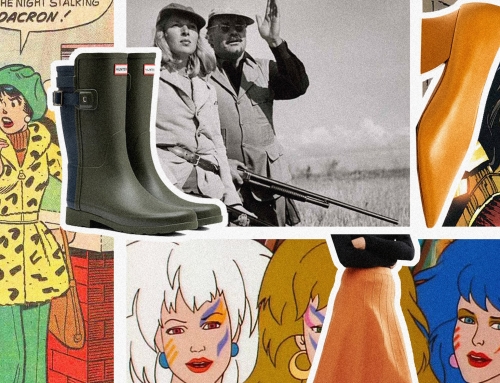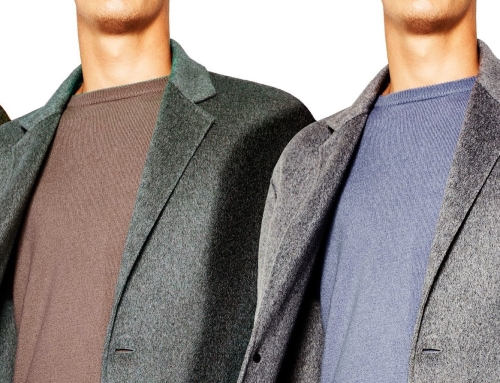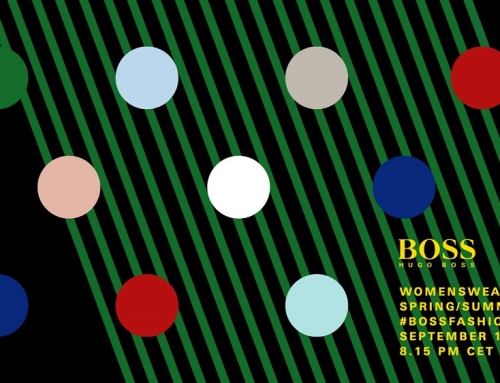Curator Andrew Bolton has headed down the rabbit hole in search of that which made Alexander McQueen what he is known for today. Where he began this mystifying journey was Lee Alexander McQueen’s upper right arm, or, to be specific, the tattoo there inscribed. The text, taken from Shakespeare’s A Midsummer’s Night Dream, states “Love looks not with the eyes but with the mind.” Although written centuries before, no better words could describe the core of what McQueen instinctively was, while simultaneously embodying what he ultimately became.
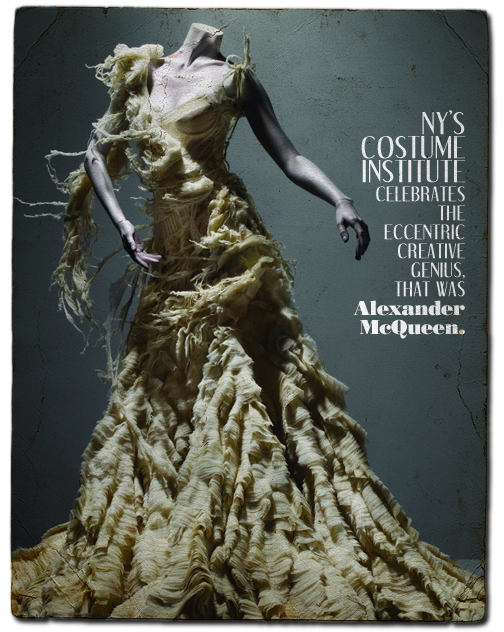
Known publicly as Alexander rather than Lee, McQueen’s career in fashion would span a decade before his untimely death at age 40, and would come to represent his history, his creative passion, and his beliefs. With just over a year between his death and the Metropolitan Museum of Art’s Costume Institute’s annual gala, Bolton took on the enormous depth of McQueen’s work, curating what he aptly titled “Alexander McQueen: Savage Beauty.” A retrospective not to be missed, the exhibit (on from May 4, 2011–July 31, 2011) brings to life the range of his work during this esteemed evening of art and fashion.
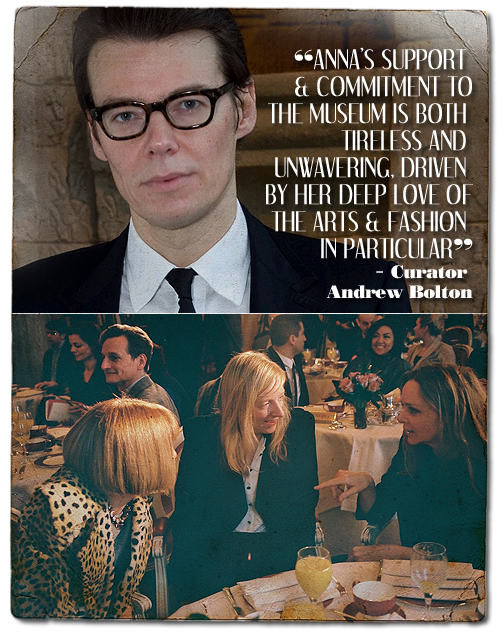
The annual benefit celebrating the opening of the exhibit takes place May 2nd this year, and is co-chaired, once again, by iconic American Vogue editor, Anna Wintour. Primarily a star-studded fundraising event, the gala evening promotes strong ties between the fashion industry and the Met’s Costume Institute, encouraging collaborations including exhibitions, acquisitions, and capital improvements. And, as the first lady of American fashion, Wintour’s involvement with the Costume Institute is integral to the evening and exhibit alike.
“Anna’s support and commitment to the museum is both tireless and unwavering, driven by her deep love of the arts and fashion in particular,” Bolton mused at a private preview at London’s Ritz Hotel during London Fashion Week in February, an event also hosted by Wintour. “[She] believes in the artistic and cultural merits of fashion passionately, and the museum is extremely fortunate to have her as its champion.”
Anna’s praise for Bolton is equally as gracious, noting that the young curator has done wonders in preserving the memory of McQueen.
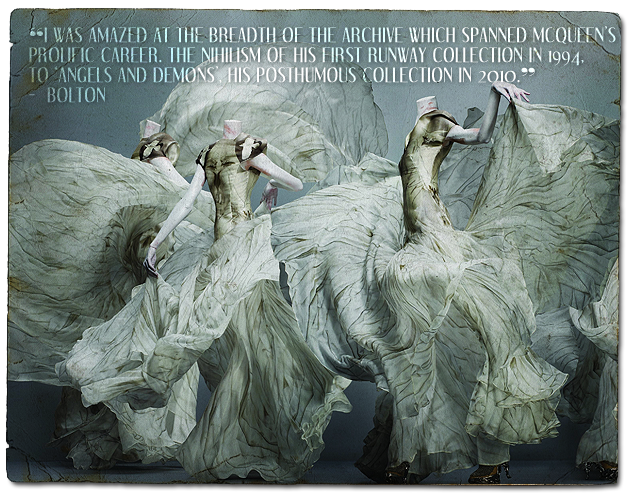
Extraordinary as the Costume Institute’s exhibit is, the gala celebrating its opening is an event unparalleled in glamour. In the past, The Costume Institute has organized exhibits featuring the works of famous designers including Cristóbal Balenciaga, Chanel, and the late Yves Saint Laurent, as well as doyennes such as Diana Vreeland, Jacqueline Kennedy Onassis, and Iris Apfel, guiding and championing the cause since the benefit element was introduced in 1948 as a midnight supper, aptly dubbed “The Party of the Year.”
When gathering material for this year’s exhibition, Bolton depended heavily on the extensive collection and the McQueen archive in London. “I was amazed at the breadth of the archive which spanned McQueen’s prolific career,” he shares. “The nihilism of his first runway collection in 1994, to ‘Angels and Demons’, his posthumous collection in 2010.” And, although the curator sees the great strides of each individual collection, he immediately detects the McQueen signature mystique prevalent in all his works.
Someone who has been there since the beginning of McQueen’s fashion reign is Philip Treacy, seasoned and celebrated milliner and often collaborator throughout McQueen’s career.
“McQueen was Isabella Blows’ other lover,” Treacy starts off by saying. “Isabella was who originally told me I should work with him. She was his biggest fan even though they had a difficult relationship.” Controversy has always surrounded Blow and McQueen’s relationship, which was spun by inspiration, talent, and assumed jealousy.
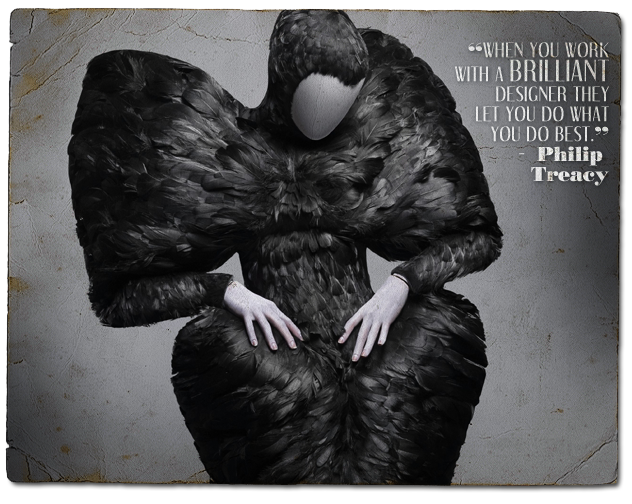
When McQueen first started, Treacy’s avant garde and decadent head pieces were already well known, having the support of Isabella Blow, style editor of Tatler at the time — a virtual career “launch” button as he says. Designing hats for Valentino, Chanel, and even the Queen, Treacy’s hats are something out of a fantasy—the ideal match for McQueen’s own fanciful visions of fashion.
“When you work with a brilliant designer they let you do what you do best,” explains Treacy, who believes creative differences are never an issue when working with the greats, a category he files McQueen under.
Much of Treacy’s collaborative work with the late designer will be on display during the retrospective. Although not partaking in the curation of the display, Treacy was approached by Bolton to have his pieces restored. “We provided hats used by the designer. We have 18 years of archive so a lot of time went into the restoration,” says Treacy.
Another designer who remained by McQueen’s side for the length of his career was designer Sarah Burton, now head designer of the House of Alexander McQueen in the wake of his passing. Bolton relied heavily on Sarah Burton as a source for stories about McQueen while compiling information for the retrospective. Other key sources include fellow designer Stella McCartney, and the late designer’s show producers Sam Gainsbury and Joseph Bennett, who provided information about McQueen as well as his editorial champion, Isabella Blow.
Presenting McQueen as muse was something that Bolton himself put forward to his Costume Institute peers, making strides in the decision to use McQueen for this year’s theme. From England, Bolton was familiar with McQueen’s early career, which aided him in the curatorial process. His existing admiration for the designer, in combination with the relative mystery surrounding the man himself, inspired Bolton to shine the spotlight on McQueen for this year’s exhibit. The curator aims to keep true to McQueen’s element of presentation, striving to highlight the culturally–embedded controversy and showmanship his designs were renowned for the world around. The centrepiece for the gallery is the ghostly apparition of Kate Moss, the finale to McQueen’s “Widows of Culloden.” Leading on from this cabinet of curiosities is a section called “Romantic Nationalism” which, as Bolton explains, “explores McQueen’s patriotic impulses.” And then there is his personal favourite of the bunch: “The stand alone collection is ‘Highland Rape,’ which is generally considered to be the collection that established McQueen’s international reputation.” Based on the 18th Century Jacobite risings, as well as the heightened appearance of the upper class living in the 19th Century, the collection, as the curator puts it, “represented a powerful but heartfelt declaration of McQueen’s Scottish national identity.” McQueen, who famously responded “everything” when asked during an interview what his Scottish roots meant to him, notably also introduced the McQueen tartan in the “Highland Rape” collection.
The House of McQueen is still operating as a successful and thriving design business. Although it is clear that his designs were appreciated well before his demise, the spirit of his creation is one that defines a genre and will be carried on. His personal impact on fashion has inspired many to explore the hidden corridors and new talents of British Fashion.
Savage Beauty will be on display at The Costume Institute from May 4, 2011–July 31, 2011.









